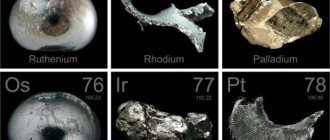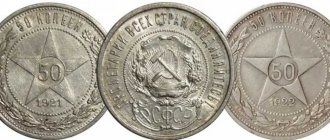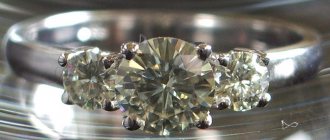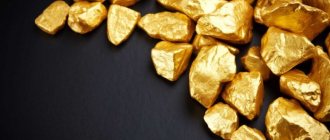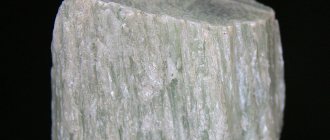There is a fairly widespread belief that gold and platinum are the most expensive metals from the periodic table. The main opponent of this statement is osmium. Few people know that the chemical element osmium is the most expensive metal, which is in position 76 in the D.I. table. Mendeleev.
Osmium is a metal with a silvery-white color and a blue tint. It is extremely rare in nature, which explains its truly incredible price. From a chemical point of view, osmium belongs to the category of platinum metals.
History of the discovery of osmium
The history of the discovery of this metal deserves special attention. They didn’t try to find him purposefully; everything happened completely by accident. An experiment was carried out on the dissolution of substances using aqua regia. During this experiment, an unknown precipitate was formed, the formula of which is OsO4. It was this precipitate that was named osmium. Translated, this word means “smell.” The fact is that the resulting sediment was characterized by a sharp unpleasant odor, which was somewhat reminiscent of chlorine, which is why the researchers gave it that name.
What is
Osmium is a noble metal, a platinoid.
76th element of the periodic table. The canonical description is brilliant silver-white with a bluish tint.
But in different forms it looks a little different:
- The ingot is distinguished by its dark blue silver color.
- Crystals obtained in the laboratory are silver-blue.
- The powder is dark purple.
International name – Osmium (Os).
It is a simple substance consisting of seven isotopes.
The name of the chemical element in ancient Greek is ὀσμή, which means “smell”.
Its origin is due to the property of the powder, when interacting with other elements, to emit a pungent, disgusting odor.
Osmium in nature
According to some data, the amount of osmium is a negligible percentage of the mass of all ores contained in the bowels of the Earth - 0.000005%. So far, not a single nugget of osmium has been found. Chemical element No. 76 is present in copper, molybdenum, nickel, platinum ores (about 0.001%), in sulfur and arsenic compounds, and gold mining waste.
Other sources are the minerals syserskite (osmium iridium) and nevyanskite (osmiridium, or osmium iridium), which are a natural alloy of osmium with iridium, and the share of the former is 10-60%.
How much does osmium weigh?
It is also worth noting that osmium is the heaviest metal, which is found in various isotopes. The most common of these is the isotope osmium-187. Modern scientists agree that this metal is most abundant in the earth's core; they believe that it makes up approximately 0.5% of its mass. The proportions between the size of this metal and its weight are very surprising. For example, if you take osmium, the size of which is equivalent to a chicken egg, then its mass will be about 1 kg. In this case, a half-liter container filled with osmium will weigh more than 15 kg. This mass is explained by the density of osmium, which is 22.61 g/cm3. It would seem like an excellent option for creating sports equipment, but that’s not the case; its incredible cost will scare off any equipment creator.
Where to find osmium
It is immediately worth noting that all enthusiasts who hope to find osmium in the forest, mountains or water can cool their ardor. To date, despite all the efforts of researchers, as well as the use of the most advanced information technologies, not a single nugget of osmium has been found. The only way to obtain osmium is by processing ores of iridium, platinum, copper and nickel. It is immediately worth noting that this process is also extremely long, since in such ore the osmium content never exceeds 0.001%.
Another way to detect osmium is through meteorites that fall to Earth from space. However, there are also certain difficulties here. In addition to the fact that meteorites are an irregular way to obtain metal, the separation of isotopes takes at least 9 months. In most cases, all industrial production is forced to use secondary raw materials, and the price of such production is slightly cheaper.
Receiving technology
Like other platinoids, Osmium is extracted from the parent rock: copper-nickel, platinum, gold.
Osmium extraction takes place in different ways:
- At a refinery in the process of purifying platinum. This is a proven, but technologically complex multi-stage procedure. First, sedimentary osmiridium is obtained. It is valuable in its own right, but sometimes the two components need to be separated. To do this, a chain of chemical reactions is carried out.
- The second method of obtaining osmium is calcination of enriched rock at 800-900°C. Osmium turns out to be spongy.
- Metal with a purity of 99.99% is obtained by chemical transportation.
However, losses during metal production are high, so more efficient technologies are being developed.
Physical and chemical properties of metal
The structure of osmium is characterized by a hexagonal close-packed crystal lattice.
Osmium itself is a hard metal of a gray-bluish color, characterized by extremely high fragility, as well as a very high specific gravity, which allows the metal to retain its luster even when maintained at high temperatures. Osmium is extremely difficult to use for mechanical processing, since its fragility, hardness and high melting point significantly complicate any technological processes.
In addition to the price, osmium is a record holder in density, which is slightly higher than that of iridium. The density of osmium is 22.61 g/cm3.
The melting point is 3033 degrees Celsius, the boiling point is 5012 degrees Celsius.
When heated, osmium reacts with oxygen, leading to the formation of various oxides. The metal also reacts with phosphorus, nitric and sulfuric acid. All compounds have oxidation states ranging from -2 to +8, the most common being +2, +3, +4 and +8.
Chemical properties table:
| Metal color | blue - grey |
| Density | 22 |
| Temperature at which metal melts | 2700 |
| Boiling temperature | 4600 |
| Electrical conductivity | 11 |
| Covalent radius | 126 pm |
| Ion radius | (+6e) 69 (+4e) 88 pm |
| Electronegativity | 2.2 (Pauling scale) |
| Electrode potential | 0,85 |
| Oxidation states | 8, 6, 4, 3, 2, 0, −2 |
| Ionization energy (first electron) | Ionization energy (first electron) |
Isotopes
There are 7 known isotopes of chemical element No. 76: Os-184 (its percentage content in the metal is the lowest), Os-186, Os-187 (radioactive), Os-188, Os-189 Os-190, Os-192 (the highest percentage content). They can exist separately, constituting varieties of natural osmium, but it is difficult to isolate any one isotope from the metal, due to the fact that they have almost the same physical and chemical properties.
The most valuable isotope is Os-187. 30% of it goes to the needs of science, the rest is used for medical and industrial purposes. It was first obtained in Germany from Norwegian molybdenum ores. Currently, Kazakhstan has a monopoly on the sale of Os-187.
Scientists have recently discovered that some isotopes emit alpha radiation, but with half-lives of trillions of years they are considered relatively stable elements.
Applications of osmium
Since osmium is one of the rarest and most expensive metals, it is used only where cost-effectiveness exists and other materials will not produce the desired results.
The use of this metal in various industries is due to its unique properties:
- Unsurpassed hardness makes this metal an ideal material for the manufacture of cutting and particularly precise instruments (cutters, scalpels, pen nibs, etc.), parts in mechanisms that experience extreme loads.
- Refractoriness promotes the use of osmium in friction units.
- The absence of magnetism allows the production of hands in compasses, watches and precision instruments.
- Due to its ability to accelerate chemical reactions, osmium is used as a catalyst, more effective than platinum.
The following industries cannot do without osmium and alloys:
- Chemical: production of ammonia, nitrogen, deep black pigment, hydrogenation, conversion of chemical energy into electrical energy in methanol fuel cells.
- Military: production of rocket artillery shells.
- Space and aviation: electronic equipment, the most important components of aircraft and rockets.
Despite the fact that osmium belongs to the group of precious metals, it is rarely used in jewelry and only as an additive to platinum.
Based on the huge price of this metal, it is assumed that it has extremely useful properties that can be used during production processes. For example, one of the main exporters of osmium is Kazakhstan, and the price for their supplies is about $10,000 per gram.
For the most part, osmium is used to create alloys that require its extremely high level of strength. Moreover, osmium gives alloys incredible wear resistance, and for a metal to have this property, even small doses of such a metal are sufficient. Thus, osmium is used in the creation of mechanical components that are constantly subject to friction.
The most valuable is the 187 isotope of osmium, which is actively used in the nuclear and space industries. It is used to create individual parts of spacecraft, as well as to make containers for nuclear waste.
Rare isotope osmium 187
This metal is also used as a catalyst for chemical processes, allowing them to accelerate. For example, osmium can significantly speed up the synthesis of chemical compounds. It is used in production, which is made by special chemical reagents, where the speed of all processes is the most important factor.
Another industry that requires the use of osmium is electronics. For the most part, this concerns the mechanisms and components of the control hardware.
However, they try to use osmium as little as possible, which is logical given its enormous price. Thus, its use in industry is due to the fact that it is able to provide a guaranteed result by imparting essential performance characteristics and properties to a specific device.
Osmium in medicine
The compound of osmium with platinum in a ratio of 1:9 is an indifferent alloy, so surgical implants, pacemakers, pulmonary valves, and some medical instruments are made from it. A promising direction is the use of osmium for the treatment of oncology.
In pharmacology, Osmium is used as a catalyst for the production of a number of drugs, for example, cortisone.
Expensive but useful
Osmium could find much wider application in the national economy (with such a set of unique properties). But its rarity and price make it possible to use the metal only where it brings the greatest benefit (or where it cannot be avoided).
The addition of osmium to alloys makes them superhard. These alloys are resistant to abrasion and are used in the rubbing parts of precision instruments.
Another property of osmium—refractoriness—has long been used in industry. Spirals for incandescent lamps have long been made from an alloy of osmium and tungsten. OSRAM has been successfully supplying lighting devices to the market for a long time.
Informative: in 1926, workers introduced the well-known pear-shaped lighting bulb. The filament was made of a tungsten-osmium alloy. All residents of Russia remember this light bulb.
The Russian military-industrial complex with its sophisticated technology requires expensive metal with unique properties.
The metal is used as a catalyst in the chemical industry (in the synthesis of ammonia).
Osmium-iridium alloy is used to make compass needles.
The isotope osmium-187 is used by paleontologists to determine the dating of layers of the Cretaceous and Tertiary periods.
Osmium metal structure
Jewelers don't like it, but...
Osmium is practically not used in jewelry. This metal is beautiful in appearance - bluish-silver. But its properties (refractoriness, malleability, plasticity) do not allow its use in creating jewelry.
Whether a fountain pen worth over a million dollars can be classified as jewelry is up to you to decide. But such pens (along with watches and other accessories) are preferred by rich and successful men; this is a sign of wealth and “status” of their owner. There are several companies that produce these pens. They are made of gold, platinum, decorated with diamonds, sapphires, rubies.
By the way, these pens really write, they are not simple trinkets. What does osmium have to do with the tip of the pen? There is always a solder on it, a small ball, so that the pen does not tear the paper, but glides gently over it. In order for the handle to work long and well, the soldering must be made of a very hard alloy. Osmium and platinum group metals fully meet this requirement.
We recommend: ANTIMONY - from eye beauty to batteries
A watch is another mark of a man from the elite. The mechanism of expensive watches uses osmium as it does not have magnetic properties. And its ability to abrasion is enormous. This means that it is necessary in mechanical watches.
Osmium compounds in medicine
Osmium tetroxide is used in the production of cortisone, a vital drug for patients with hormonal diseases. The use of osmium tetrachloride is necessary in laboratories in the preparation of samples for electron microscopes.
Surgical instruments (for example, scalpels) are equipped with cutting edges made of a platinum alloy.
These alloys are used in the manufacture of pacemakers, implants, and valves.
Why is blue platinum dangerous?
Metallic osmium is not dangerous (unless you want to eat a spoonful or two). But osmium tetroxide (OsO4), in addition to the disgusting odor, also poses a threat to human health. This is a highly toxic, volatile compound. Hazardous if vapors are inhaled. It must be stored in sealed capsules, worked in protective suits and with good exhaust ventilation.
Historical fact: K. Klaus (you can read about him in the article on iridium), as an inquisitive scientist, not burdened with analytical instruments, acted simply. By the way, many scientists did this - they tasted the substances being studied. So Klaus tried osmium tetroxide, and wrote in his work journal: “the taste of this compound is sharp, pepper-like.”
Moreover, while working with the “unscented” compound, the scientist was poisoned and was sick for a couple of weeks.
The dangerous compound irritates the skin, mucous membranes, and is harmful to the eyes.
The MPC (maximum permissible concentration) in the air is 0.002 mg/m3.
Osmium production
Osmium is obtained from the following sources:
- polymetallic ores;
- meteorite rocks;
- osmium containing minerals.
The production chain is complex. First, the ore is enriched and the main chemical element is isolated. This process produces byproducts containing microparticles of osmium. The resulting substances are calcined at a temperature of 800-900 °C. In this case, osmium oxide is formed, the vapors of which are absorbed by the sodium hydroxide solution. Then this solution is evaporated and a salt is obtained - sodium perosmate. This substance enters into a chemical reaction with hydrogen, during which pure osmium is released in spongy form.
This process is complex and expensive. To obtain 1 g of this rare metal, you need to process 5 kg of ore. This meager yield is actually the best indicator. The world produces just over 100 kg of osmium per year.
If Osmium is obtained from platinum raw materials, then when it is processed, osmiridium is formed - a compound of osmium with iridium. To separate these metals, a series of chemical reactions must be carried out, which will take up to 9 months. However, this is often not done, since such an alloy, due to its increased hardness, is used in technology.
Finally, osmium can be obtained by processing secondary raw materials.
There are other ways to produce this precious metal, but all of them are not effective enough, so new technologies are being sought.
Osmium price
This is one of the most expensive metals. In 2021, the price of 1 g was 950 rubles. This is 5 times more than 20 years ago. This increase in cost is explained by the unique properties of osmium and pent-up demand, because each of the 40 companies using it as a raw material can count on a little more than 2 kg of this platinum per year.
As for the Os-187 isotope, which medicine, astronautics, the defense industry, and science cannot do without, the picture is different: 1 g costs $10,000-20,000.
Price
The high cost is due to the limited quantity. Since it is scarce in nature and production is expensive, the market reacts accordingly. If we compare it with gold, it will be thousands of tons of gold versus several tens of kilograms of production. Hence the price - it starts from 15 thousand and reaches 200 thousand dollars per gram. On the world market, gold is 7.5 times cheaper.
Such figures indicate the unpopularity of the material for widespread use. Strength plays a major role in the use of this heavy metal in alloys. Products become incredibly wear-resistant due to the addition of very small portions of metal to the composition.
Harm of osmium
Osmium is a heavy metal, which means it is harmful to living organisms. In humans, a small concentration of vapors of this platinum in the air affects the eyes and respiratory organs, even if the poisoning was short-term. In animals, osmium causes hurricane pulmonary edema.
Prolonged inhalation of osmium leads to disruption of the functioning of any organ, blindness, and death. The skin turns green, wounds and trophic ulcers appear on it. Healing is difficult.
Benefit
Osmium is a sought-after metal in the military-industrial complex, aircraft manufacturing, technology, medicine, and scientific research. Even the most toxic substance, osmium oxide OsO4, has benefits - it serves as a catalyst in the production of medicines and a dye for research under a microscope.
The main purpose of the platinum material in question is to create ultra-strong alloys with palladium, nickel, tungsten, ruthenium, platinum, and iridium, products from which are highly wear-resistant and durable.
Where is metal used?
Osmium is the least consumed of the platinum group metals. Practical application is hampered by its rarity in nature and refractoriness: to melt the powder, it requires above 3000°C. Not every enterprise is able to provide such a melting temperature.
First ideas
The new metal remained unclaimed for a long time: people did not know where to use it. The idea came from practical Germans. They decided to make an incandescent filament from osmium. Such a light bulb shone brightly, consuming three times less energy. However, there was still no benefit, so the experiment was stopped: cheaper tungsten won.
A compromise was found at the end of the twentieth century: the transnational corporation Osram produced household incandescent light bulbs under the brand of the same name. It is derived from the words osmium and tungsten: their incandescent filaments were made from such an alloy.
Today Osmium is left to industries where there is nothing to replace it.
Industry
Superhard raw materials are in demand in advanced industries:
- This is a material for alloys of components and parts of highly precise instruments.
- The hands of clock mechanisms and measuring equipment are made from it.
- This is a microcoating of parts that experience increased friction loads during operation.
Products made from alloys with osmium are resistant to wear. They serve for decades.
The choice of type of alloy is determined by the functions of products in technology:
- Osmium plus platinum or palladium become electrical contacts.
- An alloy with nickel, tungsten, cobalt - a material for mechanically and chemically resistant tips.
- Compounds with ruthenium and iridium are multifunctional.
They are used by the military-industrial complex and aircraft manufacturers (civil and military segments).
Osmium Ingots
Chemical industry
This area is in demand for the premium properties of osmium as a catalyst - it is more effective than platinum analogues.
Metal tetroxide is purchased for different purposes:
- Pharmaceutical giants - for the synthesis of drugs.
- Without it, it is impossible to synthesize ammonia, molecular nitrogen, and hydrogenate organic compounds.
Chemistry and oil refining take up half of the available osmium.
Thanks to the osmium component, it became possible to obtain a dense black pigment for the needs of porcelain production.
Medicine
The osmium component is present in products that are subject to increased hardness requirements:
- surgical instruments;
- implants;
- pacemakers.
The materials are an alloy of osmium and platinum (osmium - 11%).
Like ruthenium red, osmium pigment creates contrast when examining biological substances (for example, human tissue) under a microscope.
Osmium can bring invaluable benefits as an oncology blocker. This direction is a priority for research work.
Jewelry
In this segment, the noble metal is the alloy of platinum alloys. Jewelry in this design is especially strong, beautiful, and durable. But these are isolated cases: there are few raw materials.
User questions about Osmium metal
Let's look at the answers to some questions that users most often ask.
Which is heavier: Osmium or Iridium
There are not 1, but 2 heaviest metals, and in the periodic table they are located in adjacent cells - osmium, No. 76, and iridium, No. 77. Their density is within 22.59 g/cm3 and 22.56 g/cm3, respectively. Thus, we can assume that the weight of these metals is almost the same.
Where is Osmium mined in Kazakhstan?
Osmium is obtained from the ores of the Dzhezkazgan deposit, one of the largest in the world. It is unique in that it almost entirely contains the isotope osmium-187. The price at which the country sells it for export, being a monopolist in this area, is below the market price and amounts to $10,000.
Why gold and platinum are no longer the most expensive metals
The fall in metal prices is due to various factors. To understand the main reasons, let's look at two of the most valuable jewelry in the past - gold and platinum.
Platinum
First of all, it is worth understanding that the price depends not only on the cost of production and rarity, but also on the significance of the metal. For example, platinum prices fell after 2015, when the diesel engine scandal occurred. It turned out that they are extremely harmful to nature. So the policy towards diesel has changed dramatically and priority has again been given to gasoline.
Here you should turn to the components from which different types of engines are made. In diesel engines, 70-80% is platinum, 18-28% is palladium, the rest is rhodium. The gasoline ratio is completely different and is 1:8:1, the materials are still the same.
Coupled with the changed policy, platinum prices began to fall rapidly, and palladium prices began to rise. Thus, by 2018, palladium had greatly increased in price, and in some cities around the world, catalysts began to be cut off from old cars to extract precious metals.
Palladium and platinum sales chart
Gold
The situation with gold prices is completely different. The main reason for the fall in prices is the Federal Reserve's interest rate hike. That is, investing in gold has become many times more expensive, but the selling price has not changed. The price is also affected by stability in the stock market: players prefer to invest in securities rather than gold.
Thus, it is not profitable for investors to invest in gold. The only major buyer at that time was China, which was actively increasing its gold reserves. This is due to the fact that in the recent past, the eastern country had to sell off its reserves in order to save the population from hunger.
However, at the moment, the demand for gold has increased again. The biggest reason is dollar inflation. Of course, this made the stock market more volatile, and gold began to stand out as one of the most stable assets. Many countries, including Russia, began to transfer assets from dollars to gold.
Gold prices from 2011 to 2021
US dollar inflation by year


